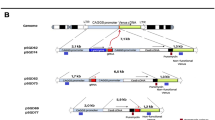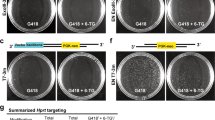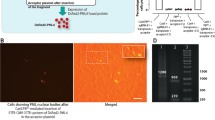Abstract
Directed mutagenesis in mammalian cells has been the focus of intense research because of its promising application for gene correction and engineering. Both natural and modified oligonucleotides (ODN), RNA-DNA chimeric oligonucleotide (RDO) and small fragment DNA (SFHR), as well as vector DNA were used for promoting homologous replacement with varying success. It was recently shown that a triple helix-forming oligonucleotide (TFO) tethered to an oligonucleotide (donor DNA) can enhance mutagenesis by homologous recombination in cells. The basic idea is to accelerate homology search by oligonucleotide-directed triple helix formation in the vicinity of the target site for donor DNA. Here we describe a new method named GOREC (guided homologous recombination) which shares similar gene targeting, but has notable difference in the concept with the previous method. It is made of a homing device (TFO) and a donor DNA for effecting distinct functions. They are linked together by non-covalent or covalent interaction. This modular concept allows guidance of either an oligonucleotide (ODN, RDO) or a small DNA fragment to the target site for homologous replacement. Therefore, the triple helix site can be hundreds of base pairs away from the target site. An episomal assay for proof-of-principle study will be presented and discussed.
This is a preview of subscription content, access via your institution
Access options
Subscribe to this journal
Receive 12 print issues and online access
$259.00 per year
only $21.58 per issue
Buy this article
- Purchase on Springer Link
- Instant access to full article PDF
Prices may be subject to local taxes which are calculated during checkout



Similar content being viewed by others
References
Gruenert DC . Opportunities and challenges in targeting genes for therapy Gene Therapy 1999 6: 1347–1348
Rice MC et al. The potential of nucleic acid repair in functional genomics Nat Biotech 2001 19: 321–326
Inoue N et al. Introduction of single base substitutions at homologous chromosomal sequences by adeno-associated virus vectors Mol Ther 2001 3: 526–530
Igoucheva O et al. Targeted gene correction by small single-stranded oligonucleotides in mammalian cells Gene Therapy 2001 8: 391–399
Goncz KK et al. Expression of DeltaF508 CFTR in normal mouse lung after site-specific modification of CFTR sequences by SFHR Gene Therapy 2001 8: 961–965
Eggleston P, Zhao YG . Gene targeting in mosquito cells: a demonstration of ‘knockout’ technology in extrachromosomal gene arrays BMC Genet 2001 2: 11
Sun JS, Hélène C . Oligonucleotide-directed triple helix formation Curr Opin Struct Biol 1993 3: 345–356
Giovannangeli C, Hélène C . Triplex-forming molecules for modulation of DNA information processing Curr Opin Mol Ther 2000 2: 288–296
Knauert MP, Glazer PM . Triplex forming oligonucleotides: sequence-specific tools for gene targeting Hum Mol Genet 2001 10: 2243–2251
Chan PP et al. Targeted correction of an episomal gene in mammalian cells by a short DNA fragment tethered to a triplex-forming oligonucleotide J Biol Chem 1999 274: 11541–11548
Datta HJ et al. Triplex-induced recombination in human cell-free extracts J Biol Chem 2001 276: 18018–18023
Biet E et al. Stimulation of RecA-mediated D-loop formation by oligonucleotide-directed triple helix formation: guided homologous recombination (GOREC) Biochemistry 2001 40: 1779–1786
Acknowledgements
The authors are grateful to Professor C Hélène and Professor Y Beuzard for helpful discussion and to Dr B Lopez for the generous gift of CHO cells.
Author information
Authors and Affiliations
Rights and permissions
About this article
Cite this article
Maurisse, R., Feugeas, JP., Biet, E. et al. A new method (GOREC) for directed mutagenesis and gene repair by homologous recombination. Gene Ther 9, 703–707 (2002). https://doi.org/10.1038/sj.gt.3301736
Published:
Issue Date:
DOI: https://doi.org/10.1038/sj.gt.3301736



